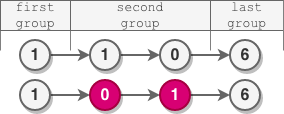2196. Reverse Nodes In Even Length Groups¶
Difficulty: Medium
LeetCode Problem View on GitHub
2196. Reverse Nodes in Even Length Groups
Medium
You are given the head of a linked list.
The nodes in the linked list are sequentially assigned to non-empty groups whose lengths form the sequence of the natural numbers (1, 2, 3, 4, ...). The length of a group is the number of nodes assigned to it. In other words,
- The
1stnode is assigned to the first group. - The
2ndand the3rdnodes are assigned to the second group. - The
4th,5th, and6thnodes are assigned to the third group, and so on.
Note that the length of the last group may be less than or equal to 1 + the length of the second to last group.
Reverse the nodes in each group with an even length, and return the head of the modified linked list.
Example 1:

Input: head = [5,2,6,3,9,1,7,3,8,4] Output: [5,6,2,3,9,1,4,8,3,7] Explanation: - The length of the first group is 1, which is odd, hence no reversal occurs. - The length of the second group is 2, which is even, hence the nodes are reversed. - The length of the third group is 3, which is odd, hence no reversal occurs. - The length of the last group is 4, which is even, hence the nodes are reversed.
Example 2:

Input: head = [1,1,0,6] Output: [1,0,1,6] Explanation: - The length of the first group is 1. No reversal occurs. - The length of the second group is 2. The nodes are reversed. - The length of the last group is 1. No reversal occurs.
Example 3:

Input: head = [1,1,0,6,5] Output: [1,0,1,5,6] Explanation: - The length of the first group is 1. No reversal occurs. - The length of the second group is 2. The nodes are reversed. - The length of the last group is 2. The nodes are reversed.
Constraints:
- The number of nodes in the list is in the range
[1, 105]. 0 <= Node.val <= 105
Solution¶
/**
* Definition for singly-linked list.
* public class ListNode {
* int val;
* ListNode next;
* ListNode() {}
* ListNode(int val) { this.val = val; }
* ListNode(int val, ListNode next) { this.val = val; this.next = next; }
* }
*/
class Solution {
public ListNode reverseEvenLengthGroups(ListNode head) {
ListNode temp = head;
ArrayList<ArrayList<Integer>> res = new ArrayList<>();
ArrayList<Integer> tempNodes = new ArrayList<>();
int req = 1;
while (temp != null) {
if (tempNodes.size() == req) {
req++;
res.add(new ArrayList<>(tempNodes));
tempNodes.clear();
}
tempNodes.add(temp.val);
temp = temp.next;
}
res.add(new ArrayList<>(tempNodes));
for (ArrayList<Integer> curr : res) {
if (curr.size() % 2 == 0)
Collections.reverse(curr);
}
ListNode ans = null;
for (int i = res.size() - 1; i >= 0; i--) {
ArrayList<Integer> current = res.get(i);
for (int j = current.size() - 1; j >= 0; j--) {
ans = addNode(ans, res.get(i).get(j));
}
}
return ans;
}
private ListNode addNode(ListNode head, int val) {
ListNode current = new ListNode(val);
if (head == null) {
return current;
}
else {
current.next = head;
head = current;
return head;
}
}
}
Complexity Analysis¶
- Time Complexity:
O(?) - Space Complexity:
O(?)
Approach¶
Detailed explanation of the approach will be added here